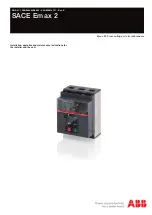
33
Instruction Book
IB182017EN February 2017 www.eaton.com
5kV, 7.5kV, & 15kV DHP-VR
Replacement Circuit Breaker
NOTICE
IF THE SPRINGS ARE TO BE CHARGED ON A CLOSED BREAKER, NO
CLICK IS HEARD AT THE END OF CHARGING OPERATION. DISCONTINUE
CHARGING AND REMOVE THE MAINTENANCE TOOL AS SOON AS
“CHARGED” FLAG IS FULLY VISIBLE. CONTINUE ATTEMPTS TO FURTHER
CHARGE MAY RESULT IN DAMAGE TO THE MECHANISM.
WARNING
ALWAYS REMOVE THE MAINTENANCE TOOL AFTER CHARGING THE
SPRING. FAILURE TO REMOVE THE MAINTENANCE TOOL FROM THE
BREAKER COULD CAUSE INJURY TO PERSONNEL AND/OR EQUIPMENT
DAMAGE IF THE BREAKER WAS TO CLOSE.
Close and trip the breaker by pushing the close lever then the trip
lever (Figure Set 3.3).
5.5 VACUUM INTERRUPTER INTEGRITY
Using a dry lint-free cloth or a paper towel, clean all the insulating
surfaces of the pole units. Conduct a vacuum interrupter integrity
check as described in Section 6.
5.6 INSULATION
Check breaker primary and secondary insulation per Section 6.
5.7 CONTACT EROSION AND WIPE
Manually charge the closing springs and close the breaker. Check
contact erosion and wipe as described in Section 6.
5.8 PRIMARY CIRCUIT RESISTANCE
Check the primary circuit resistance as described in Section 6. The
resistance should not exceed the values specified. Record the values
obtained for future reference.
5.9 SNUBBER ADJUSTMENT
WARNING
FOR ALL TYPE DHP HOUSINGS, THE ADJUSTMENT STEPS OUTLINED
IN THIS PARAGRAPH MUST BE PERFORMED BEFORE INSTALLING A
REPLACEMENT DHP-VR CIRCUIT BREAKER. FAILURE TO COMPLETE THESE
STEPS COULD RESULT IN EQUIPMENT DAMAGE AND/OR IMPROPER
OPERATION.
Before racking a breaker into any and all housings, the snubber bolts
must be adjusted as outlined in steps 1 and 2. Refer to Figures 3.4,
3.6, 3.8, and 5.8 for reference purposes. If a breaker is moved from
one housing to another, the procedure must be repeated for the
new housing.
Sttp 1
: Measure the distance from the floor plate to the underside
of the current transformer shelf on both sides of the housing in
line with the location of the snubber bolts on each side of the
breaker (Figure 5.8).
Sttp 2
: Adjust the height of the top of the snubber bolt to be
between 0.0 and 0.031 (0.0 and 1/32) inches below the measured
height of the current transformer shelf and tighten the locking
nut.
0.00” to 0.031”
Figurt 5.8. Snubbtr Bolt Adjustmtnt
otte:
N
Reference Section 3 for the
specific location of the Snubber
Bolt for each DHP-VR Rating.
5.10 ELECTRICAL OPERATIONS CHECK
After going through the above steps, the breaker is now ready to be
operated electrically. It is preferred that this check be made with the
breaker in the Test position in the breaker compartment.
Since the Type DHP-VR Circuit Breaker is for use in existing DHP
Metal-Clad Switchgear, installation procedures are similar. If it is
necessary to reference anything in the breaker compartment, refer
to the original instruction books supplied with the assembly.
Refer to Figure Set 3.3, depending upon the voltage rating of the
breaker, for any parts identification required during these installation
procedures
a. The circuit breaker’s faceplate and barriers must be positioned
properly and securely bolted in position before inserting the
breaker into the cell.
WARNING
EXAMINE THE INSIDE OF THE CELL BEFORE INSERTING THE BREAKER
FOR EXCESSIVE DIRT OR ANYTHING THAT MIGHT INTERFERE WITH THE
BREAKER TRAVEL.
WARNING
KEEP HANDS OFF THE TOP EDGE OF THE FRONT BARRIER WHEN PUSHING
A BREAKER INTO A CELL. FAILURE TO DO SO COULD RESULT IN BODILY
INJURY, IF FINGERS BECOME WEDGED BETWEEN THE BREAKER AND
THE CELL. USE THE HANDLES PROVIDED ON THE FRONT OF THE BREAKER
FACEPLATE, OR USE BOTH FULLY OPENED HANDS FLAT ON THE FRONT OF
THE FACEPLATE.
b. Position the breaker in front of the cell, and line up the guide
channel on the rear right hand side of the breaker near the
floor with the guide rail on the right hand side of the cell floor.
Once the breaker is aligned with the cell floor guide, push the
breaker into the cell until the rail latch at the front of the guide
channel catches in a notch in the guide rail, and prevents further
movement of the breaker toward the rear of the cell (Figures 5.9).
The breaker is now in the Test position, and secondary contacts
can be engaged.
Figurt 5.9. Instrtion of 15kV DHP-VR





































